The following images illustrate the use of air set refractory mortar in this case Refracol 1.
Other terms used for refractory mortar are high temperature cement, and fire clay.
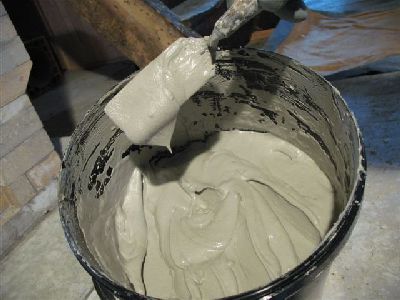
On opening a new bucket of mortar, it is important to thoroughly stir the contents. Due to the agitation of transport the consistency of the mortar may no longer be homogeneous. The heavier aggregate will have tended to fall to the bottom of the bucket and the sodium silicate rise to the top. If not stirred, the portion at the bottom will be weak in sodium silicate.
During initial stirring it is common practice to add water in order to bring the mortar to a workable consistency. When liquid enough, if a refractory brick is placed on the surface, half of the brick should sink into the mortar. This though is only a general rule and each mason will add water until arriving at their own preferred consistency.
During initial stirring it is common practice to add water in order to bring the mortar to a workable consistency. When liquid enough, if a refractory brick is placed on the surface, half of the brick should sink into the mortar. This though is only a general rule and each mason will add water until arriving at their own preferred consistency.
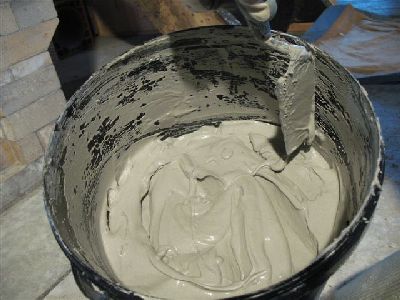
If no water is added when opening a new bucket it will be difficult to lay the brick with the extremely tight joints required.
As work progresses and relatively dry 'scrape off' is remixed back into the bucket it will become necessary to add more water to maintain the original consistency.
While working it is important to keep the inner surfaces of the bucket free from mortar 'scrape off' that is scraped back onto the inner rim of the bucket - it can dry surprisingly fast, and when mixed back in, will cause the contents of the bucket to be lumpy.
At lunch time and breaks, the bucket should be firmly closed with its lid.
As work progresses and relatively dry 'scrape off' is remixed back into the bucket it will become necessary to add more water to maintain the original consistency.
While working it is important to keep the inner surfaces of the bucket free from mortar 'scrape off' that is scraped back onto the inner rim of the bucket - it can dry surprisingly fast, and when mixed back in, will cause the contents of the bucket to be lumpy.
At lunch time and breaks, the bucket should be firmly closed with its lid.
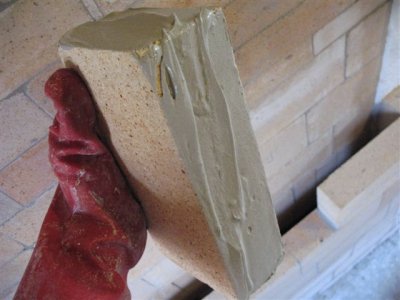
There are two methods of applying mortar to the brick. The mortar can be spread onto the brick with a margin trowel. Or the brick can be 'dipped' directly into the bucket, with excess mortar being scraped off by trowel.
Using a margin trowel is important as the square end enables hardening mortar to be completely scraped from the bed in instances where a brick must be re-layed, and new mortar applied.
Mortar is, as a rule, applied to the brick and never to the bed on to which it will be layed.
Using a margin trowel is important as the square end enables hardening mortar to be completely scraped from the bed in instances where a brick must be re-layed, and new mortar applied.
Mortar is, as a rule, applied to the brick and never to the bed on to which it will be layed.
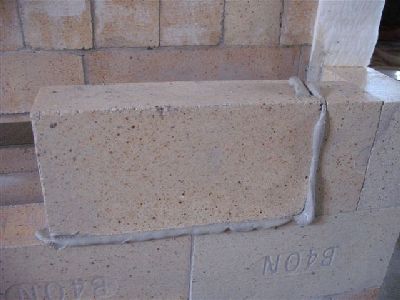
As the brick is layed, mortar should be seen to squeeze out from all the length of the bed and head joint, ensuring 100% contact.
Squeeze out should be scraped off by trowel immediately after laying and scraped back into the bucket.
Refractory brick should always be dry when layed, though superficial moisture from a long saw cut is not detrimental.
Due to the brick being dry, and tight joints required, it necessary to lay the brick a quickly as possible after the mortar has been applied. The rate at which the mortar is affected by sorption once applied to the brick will vary between different brands of brick, and mortar.
Refractory brick should always be dry when layed, though superficial moisture from a long saw cut is not detrimental.
Due to the brick being dry, and tight joints required, it necessary to lay the brick a quickly as possible after the mortar has been applied. The rate at which the mortar is affected by sorption once applied to the brick will vary between different brands of brick, and mortar.
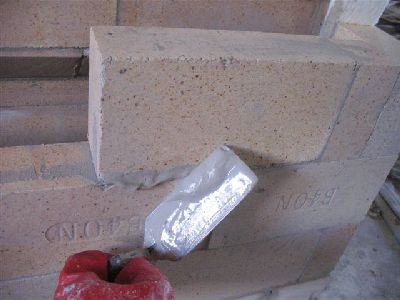
Joints should never be more than 3mm thick with 1mm and less being optimum.
Some stove builders, using very liquid mortar will, when laying, slide the brick backwards and forwards along the bed until it is felt to physically contact the brick below.
With most quality brick being extremely uniform, once the first row has been leveled subsequent rows will not need to be checked for level.
On the occasions that a brick needs to be knocked into place with a hammer, it is preferable to use a brick hammer rather than a rubber mallet.
Though care must be taken not to crack the brick, the sharp directly transfered shock of a blow from a hard hammer is way more efficient than that of a dull blow from a soft mallet.
With most quality brick being extremely uniform, once the first row has been leveled subsequent rows will not need to be checked for level.
On the occasions that a brick needs to be knocked into place with a hammer, it is preferable to use a brick hammer rather than a rubber mallet.
Though care must be taken not to crack the brick, the sharp directly transfered shock of a blow from a hard hammer is way more efficient than that of a dull blow from a soft mallet.
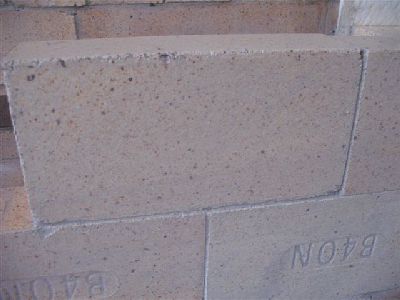
As regularly as possible the work should be sponged down with a wet sponge. This keeps the work clean, allowing the 'eye' to be in full control, and not distracted by variations in texture and color. Also mortar allowed to dry in to the work can effect the accuracy of the level if the work is being checked for plumb.
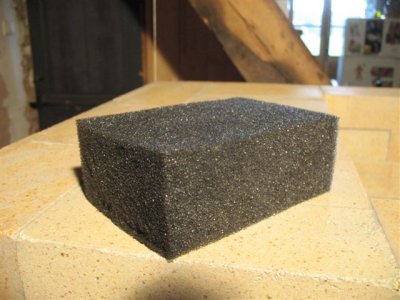
A professional cellulose tilers sponge will last longer and make sponging much easier than a domestic sponge.
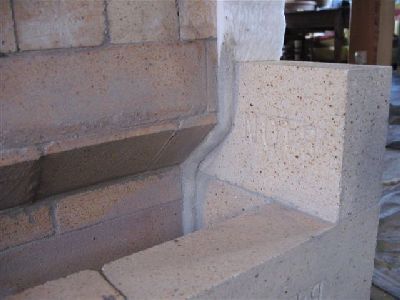
HTC can be used to parge the surface of a ceramic wool or paper gasket. This provides a thin, though resistant, layer of mortar to the exposed surface of a gasket. A very liquid mix of mortar and water is applied by sponge or paint brush.

Refractory mortar can also be used to hold strips of ceramic wool in place.
It is important to wear gloves as both the clay base of the mortar and the sodium silicate are extremely astringent. Tools, especially levels should be wiped clean regularly. Many stove builders oil their levels at the start of each day.
The margin trowel should only ever be placed in the mortar bucket, the sponge bucket or upon the work. Keeping the mortar bucket free from granular contaminants is important.
It is important to wear gloves as both the clay base of the mortar and the sodium silicate are extremely astringent. Tools, especially levels should be wiped clean regularly. Many stove builders oil their levels at the start of each day.
The margin trowel should only ever be placed in the mortar bucket, the sponge bucket or upon the work. Keeping the mortar bucket free from granular contaminants is important.
The air set mortar generally used on heaters, will remain soft in the bed inside of the joints for weeks if not months, making removal of brick relatively easy at any time
All air set mortars will remain soluble in water, unless fused. This should be noted when protecting flue tiles layed in refractory mortar from potential water infiltration.
The use of refractory mortar to lay any elements of the facing, even if hidden behind a common mortar joint, is not recommended
Marcus Flynn
2008
